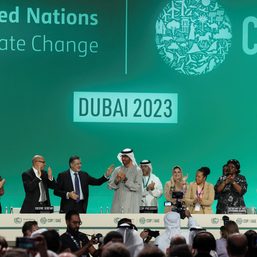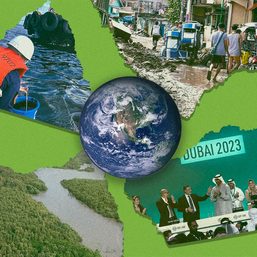SUMMARY
This is AI generated summarization, which may have errors. For context, always refer to the full article.

LONDON, United Kingdom – From Afghanistan to Somalia, countries affected by conflict are often highly vulnerable to climate change impacts as well.
Wars and insecurity, and absent or problematic governments, can make getting help to the people who are most at risk from extreme weather, crop failure, or other climate change-related threats hugely challenging.
Tough requirements donors face, to show money is being used effectively, also stand in the way of cash flowing to fragile countries, where the need for help is high, but tracking how money is spent can be more difficult.
However, a range of innovative efforts are underway to get help to those who need it most, even under difficult conditions.
Here’s why that matters, and how it might happen:
Why are conflict-affected and climate-hit countries often the same places?
Politically fragile or conflict-hit countries such as Somalia, South Sudan, Syria, Afghanistan, Yemen, and a range of nations in Africa’s Sahel often also feature on lists of countries most at risk from climate change.
In many cases, their vulnerability to climate impacts – droughts, floods, extreme heat, and crop failures – stems not just from the kind of extreme weather now facing a growing share of the world, but from a lack of investment to prepare for it.
Countries in conflict, or with weak, corrupt, or internationally isolated governments, may not see adapting to growing climate risks as a priority, or have the expertise or funding to do so effectively.
Countries in upheaval often also lack other systems that could help lower risks for their people, from extreme weather early warning networks to irrigation systems and social safety nets that could provide a basic income to those who lose their crops, jobs, or homes.
With little state or international support, those living in fragile, conflict-hit, or other highly vulnerable nations often end up covering losses with their own limited savings or assets, undermining their ability to recover from ever-more-frequent shocks.
Why is getting climate funding to conflict-affected countries important?
For many years, aid agencies have responded to humanitarian disasters in countries hit by weather shocks and conflict, providing emergency food and other help.
But as climate change and geopolitical shocks like Russia’s invasion of Ukraine drive soaring demand for aid and higher prices for the wheat and other crops often provided as assistance, aid agencies are struggling to keep up.
The international aid system was already “overwhelmed” by rising need and inadequate funding before the Russia-Ukraine war, said Gernot Laganda, the climate and disaster risk reduction chief at the UN World Food Programme, last year.
That suggests as climate change brings worsening shocks, overwhelming aid networks, vulnerable people with few remaining options may need to migrate – or could simply die or face human trafficking or other perils – unless new ways to deliver help are put in place.
Those could include a promised doubling of international funding to help countries adapt to climate change and a well-resourced UN “loss and damage” fund, among others – though neither are likely to meet surging need.
Rethinking the mission of global development banks, to ensure more cash goes where it is needed most, and ensuring development, climate resilience, and humanitarian efforts work in a joined-up way could also help, as could letting local people have a strong say in how money is spent, experts say.
How might money effectively flow to fragile nations, especially if governments are absent or part of the problem?
Working through powerful local authorities, such as well-established and respected religious bodies, traditional leaders, or civil society groups, can be one potential solution, said Melissa Leach, director of the Institute of Development Studies at Britain’s University of Sussex.
In Taliban-ruled Afghanistan, Afghans living overseas have channeled donations to help drought-hit farmers build small dams via a mosque in northern Germany, with cash-strapped farmers paid for their labor in building the dams.
The effort was overseen by a nongovernmental group in the country.
Analysts say such creative efforts to help vulnerable communities adapt – but paid for with significant international finance rather than simply donations – are crucial to improving the safety of vulnerable communities.
Slashing the fossil fuel emissions driving worsening climate change impacts is also key.
“It makes no sense to keep giving food aid but not invest in climate adaptation projects that will help people grow their own food,” Najibullah Sadid, an Afghan water specialist based in Germany, told the Thomson Reuters Foundation.
“If you don’t target the root of the problem, the hunger will go on forever.” – Rappler.com
Add a comment
How does this make you feel?

![[OPINION] Hoping amidst ‘this thing’: COP28 reflections from a 24-year-old first-timer](https://www.rappler.com/tachyon/2024/01/imho-c0-28-reflection.jpg?resize=257%2C257&crop=297px%2C0px%2C720px%2C720px)

![[OPINION] Is limiting warming to 1.5°C still alive after COP28?](https://www.rappler.com/tachyon/2023/12/imho-cop28.png?resize=257%2C257&crop=285px%2C0px%2C720px%2C720px)

There are no comments yet. Add your comment to start the conversation.